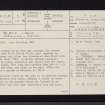Black Loch
Crannog (Period Unassigned)
Site Name Black Loch
Classification Crannog (Period Unassigned)
Alternative Name(s) Loch Of Sanquhar
Canmore ID 45495
Site Number NS71SE 6
NGR NS 7970 1068
Datum OSGB36 - NGR
Permalink http://canmore.org.uk/site/45495
- Council Dumfries And Galloway
- Parish Sanquhar
- Former Region Dumfries And Galloway
- Former District Nithsdale
- Former County Dumfries-shire
NS71SE 6 7970 1068
For logboat found in Black Loch, see NS71SE 34.
(NS 7971 1067) Lake Dwelling (NR)
OS 6" map (1958)
A typical example of an Iron Age crannog, the wooden platform, some 49 ft E-W by 40 ft, kept together by morticed beams and piles, was discovered when Black Loch was drained about 1860. A narrow curving causeway, supported by piles, connected the island with the shore. A dug-out canoe, 16ft long and tapering from 3ft to 1 ft 10 ins at the prow, was found in the mud. (This was decaying in a garden in Sanquhar in 1891).
A small whetstone found on the site is in Dumfries Museum, and a perforated flat stone, perhaps a sinker or loom weight (also in the museum) which "picked up on Sanquhar Moor" may have some connection with the site.
J Brown 1891; RCAHMS 1920, visited 1912; J G Callander 1925; G F Black 1894; A E Truckell 1966; Trans Dumfriesshire Galloway Natur Hist Antiq Soc 1942
NS 7970 1068. The crannog, dimensions approximately as described, survives as a mud-flat 0.5m above the water level. It retains no significant features apart from a possibly artificial inlet on its north side. No causeway is visible.
Mr J B Williams of Lochside, Sanquhar, found the partially perforated base of a bun quern at the side of Black Loch approximately 20 years ago. It is now in the front garden of Lochside (NS 794 102).
Visited by OS (JRL) 7 April 1978.
As the underwater component of Phase 2 of the South West Crannog Survey, the state of preservation of 14 crannog sites was evaluated in 12 lochs throughout Dumfries and Galloway as part of the Scottish Wetland Archaeology Programme (SWAP).
NS 7970 1068 Black Loch of Sanquhar (NS71SE 6). The crannog in this small peat bog loch measures 15 x 12m and is visible to a height of c 50cm above water. It is largely featureless other than a small cutting in the N side, which is probably the result of documented 19th-century antiquarian disturbance. Horizontal timbers were noted buried beneath the silt in two places. Three oak piles were noted on the E side of the mound.
Sponsors: HS, Scottish Trust for Archaeological Research, AOC Archaeology Group, University of Nottingham
M G Cavers and J C Henderson 2002.
Black Loch of Sanquhar (Nith catchment): location cited as NS 7970 1068.
The existence of this crannog was reported in 1863, when the loch was drained. It was then described as a wooden platform held together held together by mortised beams and piles. The discovery of two logboats [logboat: NS NS71SE 34] is also recorded in the loch.
The remains of this crannog were surveyed in July 2002 during the 2nd phase of the South-West Scotland Crannog Survey, with the intention of establishing an effective system of monitoring the rate of organic decay. No underwater investigation was feasible in this case, and it was not considered suitable for continued monitoring.
This crannog is situated in the middle of a sedge and sphagnum bog, and was found to be difficult of access as the ground becomes very wet and boggy about 100m from the loch. The water depth was 0.5m to the top of very deep deposits; no firm bottom was discernible, and suspended sediment precluded in-water visibility.
The crannog survives as a peat island (measuring some 15m by 12m) about 0.5m above water level. It is featureless, apart from an artificial inlet on the N side; this was probably formed during the 19th century excavations, to record a section. Some stones are visible around the rim.
Underwater, the slopes down gently to 0.5m depth, and is covered with thick silt, which presumably protects the core of the crannog. Search underwater revealed firmly-embedded horizontal timbers in only two places some 4 or 5m from the NE edge of the mound. A group of three oak piles was located in situ some 1.5m off the Eastern edge of the mound, and may form part of the causeway noted in previous investigations. One of these piles was sampled for radiocarbon dating. [No radiocarbon results cited].
J C Henderson, B A Crone and M G Cavers 2003.










